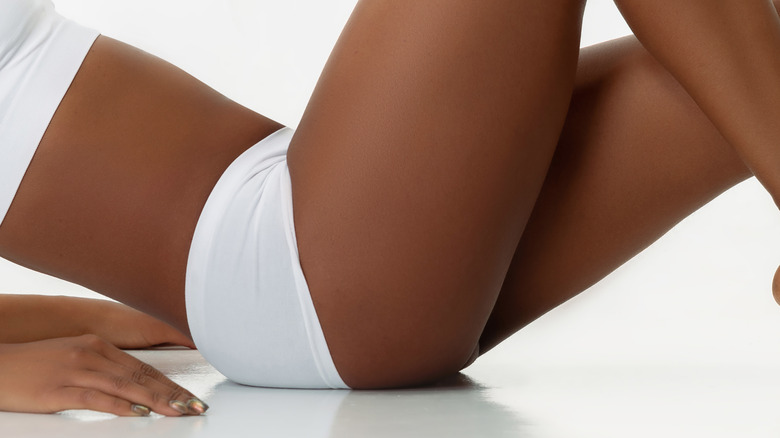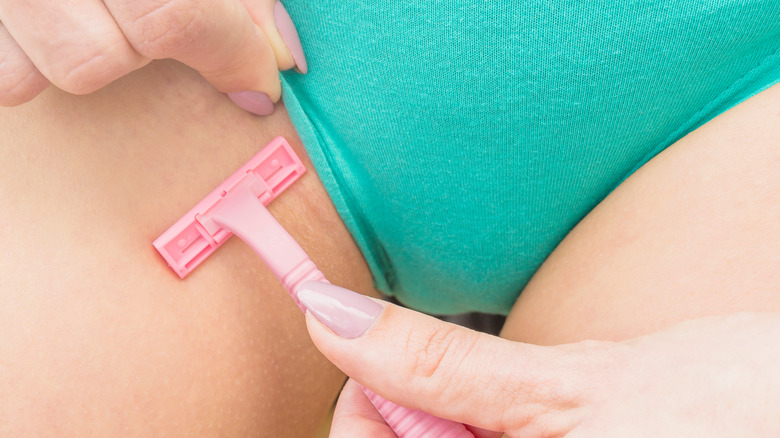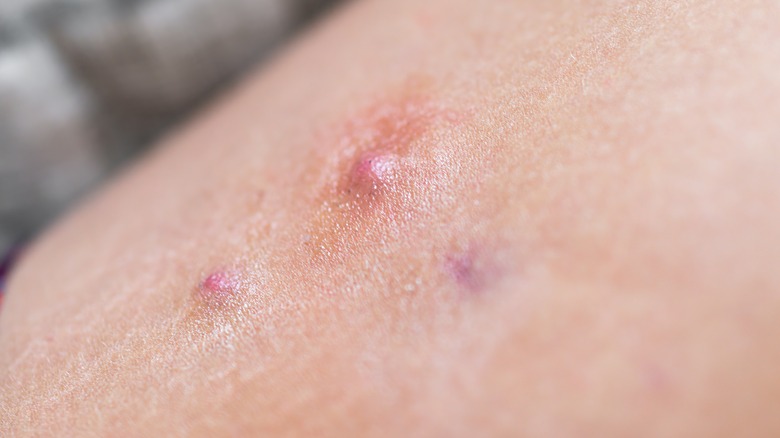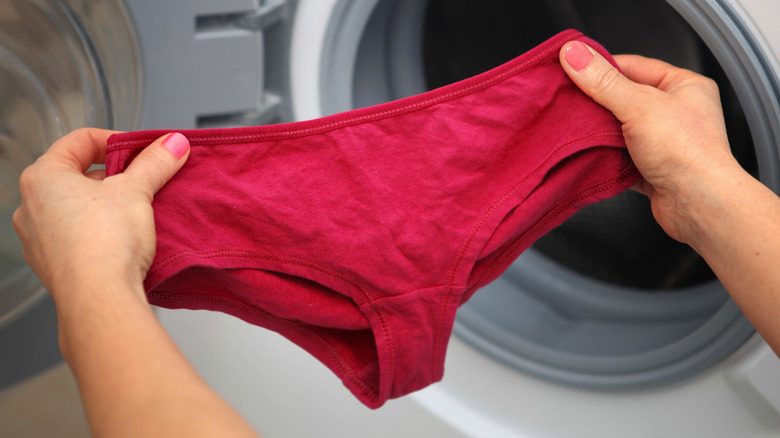Vaginal Acne Is Awkward, But Normal (Usually). How To Know When It's Cause For Concern
It is reasonable to worry whenever acne appears on private body parts. One might even feel shame when it happens in sensitive areas such as the vulva. Experts, however, reassure us that vulvar or vaginal acne is normal — most of the time. "[The vaginal area] has sweat glands and hair follicles that are prone to buildup, just like any other part of the body," gynecologist Sherry Ross, M.D., explained to Teen Vogue.
Pimples that sprout on the genitals usually resemble those that develop on the face: red bumps that appear either alone or in small clusters, occasionally with pus-filled whiteheads. Like facial acne, these bumps can feel painful, especially if they live deep in the dermis and are quite inflamed. Other times, they are merely itchy or even painless. And just as dermatologists advise against popping and picking at your facial zits, they also do not recommend unnecessarily touching those in your vaginal area.
When caused by minor skin irritations, pimples clear up on their own soon enough as long as you maintain proper skin hygiene. Vaginal acne, however, can have several sources, and determining the best mode of treatment hinges on understanding its cause. It also requires getting more up close and personal with your netherregions to monitor any changes in your skin condition.
So when you feel a bump developing in your vaginal area, including your bikini line, wash your hands and grab a hand mirror. You need to inspect and better understand what's going on down there.
Folliculitis
A common infection that happens in the genital area is folliculitis, or the inflammation of the hair follicles, which is technically not the same as acne despite looking similar to it. According to the Mayo Clinic, this condition has two general types: superficial, which involves only a section of the follicle, and deep, where the whole follicle is affected.
Certain health conditions contribute to folliculitis, such as hyperhidrosis (excessive sweating) or a weakened immune system. However, some lifestyle practices also make hair follicles susceptible to inflammation.
Wearing tight underwear made of non-breathable fabric is one, as is frequently donning tight pants. These trap heat and sweat in the groin, heightening the risk of bacterial buildup in the follicles. Another risky practice is shaving, waxing, or plucking the bikini area, which can prompt the pubic strands to grow out by curling back into the skin, resulting in ingrown hair. Also called pseudofolliculitis pubis, this condition can be itchy and painful. Another type of follicular inflammation is pseudomonas folliculitis or hot tub rash. It develops a day or two after exposure to hot water in improperly cleaned public pools.
Superficial folliculitis generally heals within a few days, granted that you observe proper hygiene and reduce the risk factors that caused it. However, when it's serious enough that painful boils form on the skin, getting immediate medical attention is necessary to avoid the spread of infection. When left untreated, severe folliculitis can lead to hyperpigmentation and the development of pustules or pus-filled lesions.
Hidradenitis suppurativa
Another type of hair follicle-related skin problem is hidradenitis suppurativa, also known as acne inversa. It develops whenever the hair follicles get clogged, leading to inflammation and possible follicular rupture.
However, unlike folliculitis, the reasons behind this blockage aren't known. It usually happens in areas where the skin tends to chafe and sweat: the armpits, groin, buttocks, and breasts. Experts cite genetics, hormones, excess weight, smoking, and dietary habits as risk factors, and Medical News Today links diabetes, metabolic syndrome, heart disease, polycystic ovary syndrome (PCOS), and inflammatory bowel disease (IBD) as health issues that contribute to its development. Experts also state that Black female teenagers and Black women in their 20s are at higher risk.
It is important to note that hidradenitis suppurativa is a chronic condition that's neither contagious nor caused by poor hygiene. It also has no known cure.
Because it manifests initially as a painful lump, people often mistake it for an ordinary pimple. However, hidradenitis suppurativa doesn't clear up within weeks, and often returns even after treatment. The lump can also grow, with new ones appearing later on and tunnels forming underneath the skin, linking them. These bumps can then become lesions that leak blood or pus. Pain and the restriction posed by the resulting scar tissue make moving the infected area difficult, and given where these bumps develop, the lymph drainage system can also get affected. Managing this condition requires a treatment plan from a dermatologist, along with support from other specialists.
Contact dermatitis
Shaving and waxing are already probable culprits in the development of folliculitis, but we should also take into account the products we typically use to make hair removal effective. In fact, any product that comes in contact with our genitals, such as cleansers, vaginal washes, sanitary pads, or even the detergents and fabric softeners we use to launder our underwear, can have ingredients that irritate the vaginal area's sensitive skin.
A rash that breaks out in the groin can be a case of contact dermatitis. Aside from red bumps and pus-filled blisters, its other symptoms are dry, scaly, or leathery patches of skin accompanied by some swelling and tenderness in the affected area. Contact dermatitis tends to clear up within two to four weeks, provided you have identified its source and avoided using it since.
It can be very itchy, though, and scratching or rubbing the area can lead to wounds and oozing blisters that attract fungi and bacteria, causing further infection. Better to soothe the skin with a cool, wet cloth then carefully dry the area afterward. If the itchiness becomes so severe that it impacts your sleep and general quality of life, consult your dermatologist for a safe way of alleviating it.
When should you worry?
Vaginal acne that isn't rooted in genetic or hormonal factors typically clears up within a few days, especially if you take care to keep your groin clean and dry and avoid scratching or popping your pimples. But when a red bump is persistent and becomes bigger or more painful, it's best to check with a dermatologist who can prescribe an effective treatment, from topical medication and antibiotics to cortisone shots.
Visiting a gynecologist is also helpful. Jessica Shephard, an OB/GYN, told Teen Vogue, "If genital pimples are recurring and don't seem to go away, go to your gynecologist to have them evaluated to make sure they are not a sign of a sexually transmitted infection (such as genital herpes or warts)." This applies especially if you're sexually active and haven't been practicing safe sex. While STDs or STIs are more severe — not to mention more uncomfortable and painful — than vaginal acne, some initially manifest as a pimple-like growth. When it's accompanied by fever, difficulty in urinating, vaginal discharge, and a foul odor, seek medical help immediately.
Whether it's a case of vaginal acne or something more serious, there's nothing shameful about getting the treatment you need. Vaginal acne, in particular, is incredibly common thanks to the grooming practices that we expose ourselves to.
As advisable as prevention is, having intimate knowledge and understanding of what's happening down there lessens the stigma and panic over a totally normal condition.




